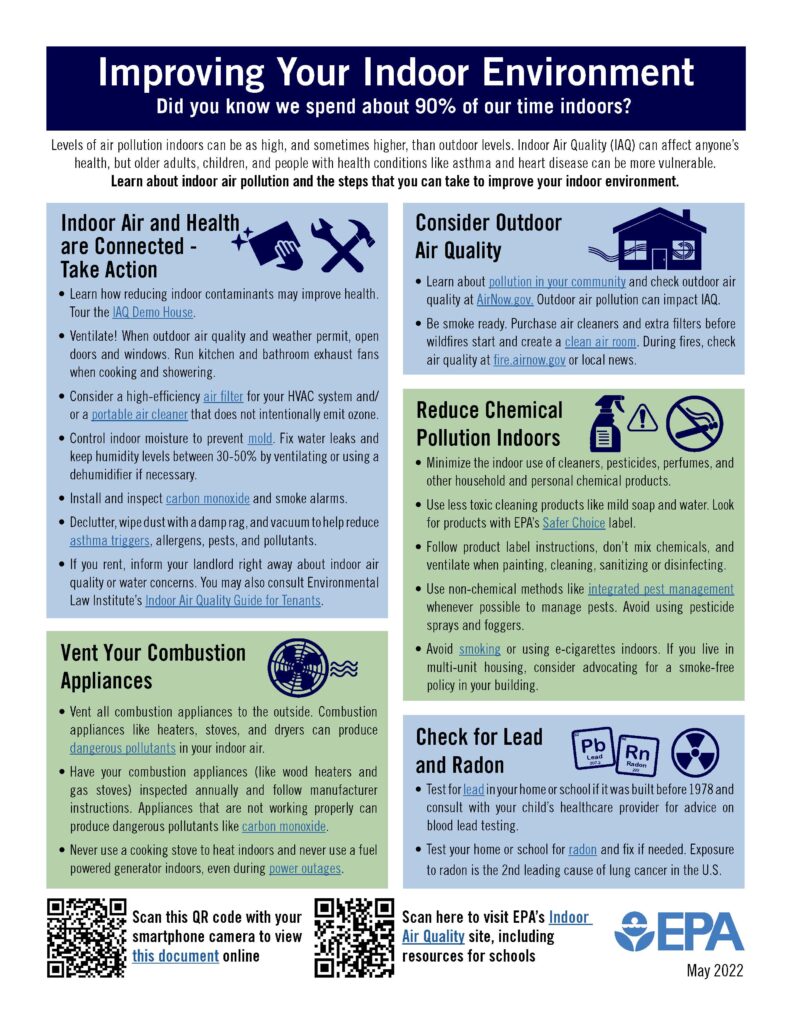Winter Air Care: Improving Air Quality and Lowering Cancer Risk Indoors

According to the U.S. Department of Energy, Americans spend about 90% of their time indoors in schools, workplaces, restaurants, shops, homes, places of worship, or elsewhere. The everyday spaces we spend time in become even more important during the winter months as we escape cold weather. The U.S. Environmental Protection Agency (EPA) cautions that as buildings are sealed up to conserve heat during the winter, potentially harmful pollutants are also trapped inside. Because of this, it is important to ensure the air inside such buildings is safe to breathe with low or no concentrations of indoor air pollutants, especially ones that can cause cancer or make the body more susceptible to developing it.
WHAT MAKES INDOOR AIR UNHEALTHY?
In addition to radon, the naturally occurring radioactive gas that is found in 5 out of 7 Iowa homes (learn more), indoor air contains other gases and particles that may cause health problems like cancer. They originate from a variety of sources like building materials, household cleaners, secondhand smoke, aerosols, mold, or combustion appliances. More vulnerable populations who are often exposed to higher levels of indoor pollutants include households of low socioeconomic status, Native Americans, older adults, children, and individuals with preexisting conditions like asthma or heart disease.

Source: U.S. EPA: Indoor Air Pollutants
THE CONNECTION BETWEEN AIR QUALITY AND CANCER
Not every gas or particle in the air is cancer-causing. Researchers are studying how mixtures of different substances affect human health outcomes like cancer, as well as the relationship between air quality and cancers in other parts of the body besides the lungs. When considering indoor lung cancer risk factors, secondhand smoke and radon are the first two that may come to mind. Exposure to both secondhand smoke and radon in indoor air enhances lung cancer risk, since they have a synergistic effect as radon particles attach to secondhand smoke particles in the air. There are other carcinogenic indoor air pollutants that exist and can be modified to reduce cancer risk. Asbestos found in building materials is also a known human carcinogen, and its ongoing uses were fully banned this year by the EPA in an effort to protect people from cancer. Volatile organic compounds that can cause cancer like benzene and formaldehyde are not only found in cigarette smoke, but also fuel-burning appliances, paints, detergents, or other household and cleaning products.
It is also important to consider outdoor air pollutants that can get inside. In 2013, the World Health Organization’s International Agency for Research on Cancer (IARC) classified outdoor air pollution as carcinogenic to humans, with sufficient evidence that exposure causes lung cancer and can increase risk of bladder cancer. However, air pollution is not just a risk people face outside. Outdoor air does not just stay outdoors and can affect the quality of air inside buildings, too. Particulate matter, which is found in both outdoor and indoor environments, was also classified as carcinogenic to humans. Air pollution levels indoors can be just as high, if not higher, than outdoors.
YOU’VE CONTROLLED FOR RADON, WHAT’S NEXT?
The air we breathe is a mixture of substances that may or may not cause cancer on their own, so it is important to consider how they interact in an indoor environment. The U.S. Environmental Protection Agency and the American Lung Association provide more details on what determines indoor air quality and how it can be protected during winter weather, when loss of electricity, burst pipes, or other hazards may be more likely. Here are the basics:
- Keep the space smoke-free.
- Use and properly maintain ventilation system.
- Properly vent combustion appliances (wood-burning or gas stoves, fireplaces, etc.)
- Run a generator outdoors and away from windows to power your home or business if you lose power.
- Check smoke and carbon monoxide detectors.
- Consider transitioning to electric appliances. The Iowa Energy & Infrastructure Funding Hub provides information on federal funding opportunities available to Iowans to help with this transition.

Source: EPA
RESOURCES
The EPA offers a room-by-room interactive tour in English and Spanish of a home (which can be applied to other spaces!) to learn more about common pollutants in indoor air and how to address them. They also have an introduction to indoor air quality information for health professionals.
NOTE ABOUT ASSISTANCE FOR NAVIGATING EPA MATERIALS
If you or the community you are serving cannot speak, read, write, or understand the English language, or have disabilities and need modifications and/or auxiliary aids and services, you can email [email protected] to request interpretation, translation, or other services free of charge.
